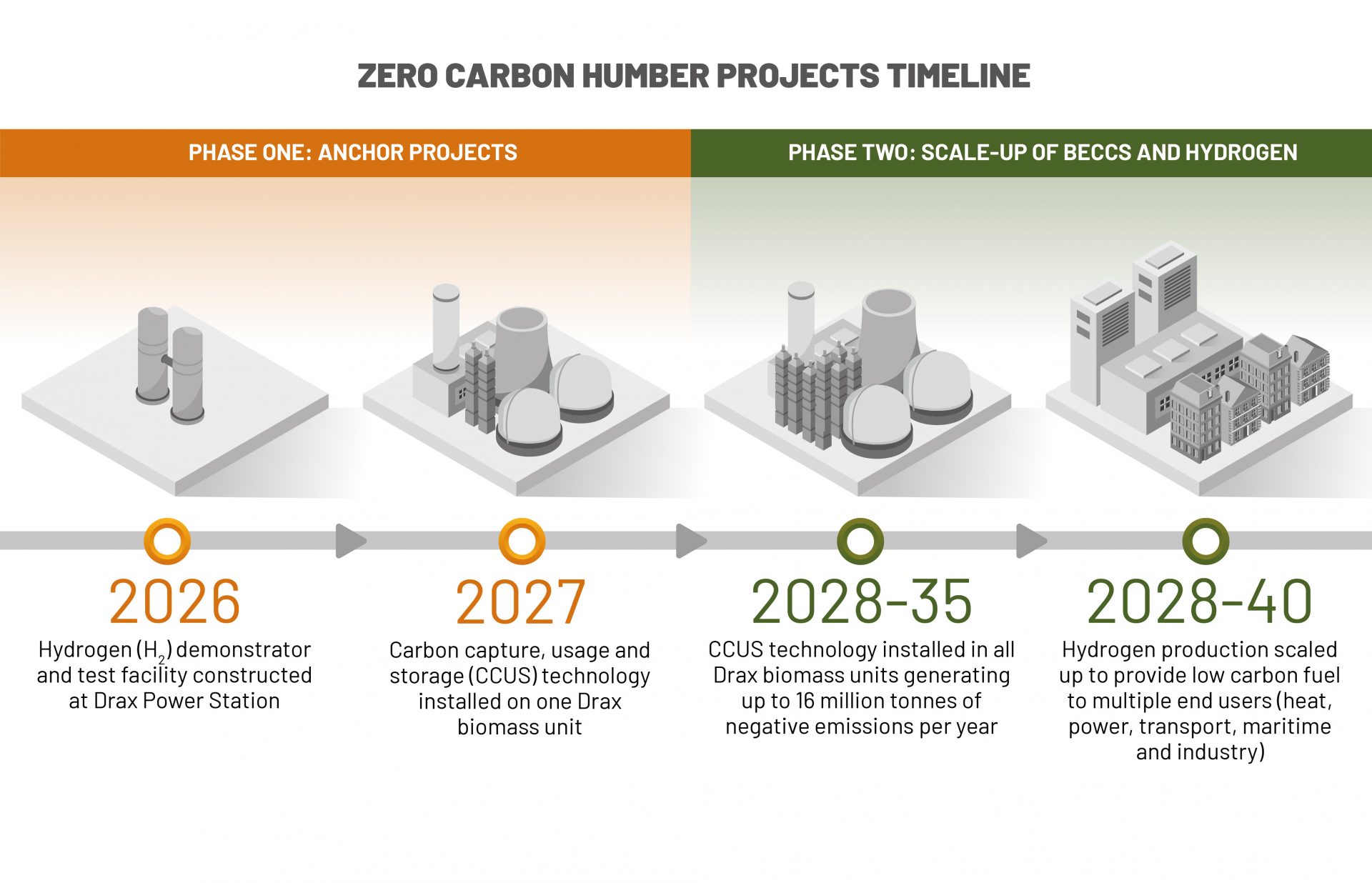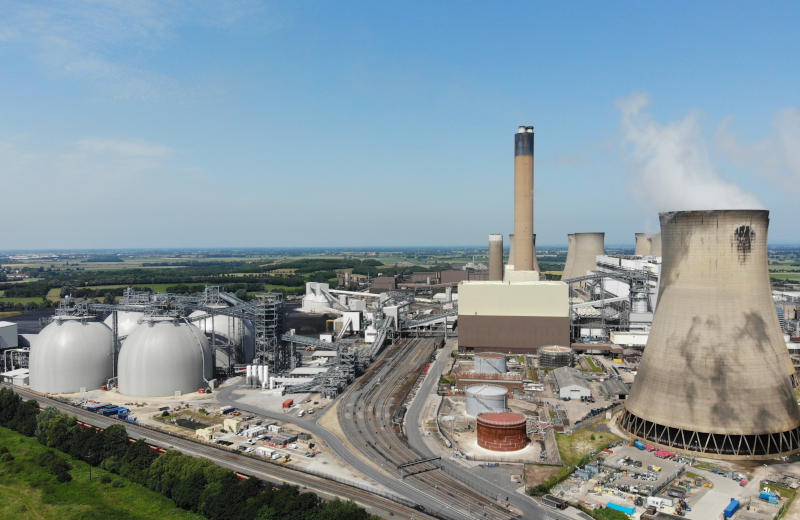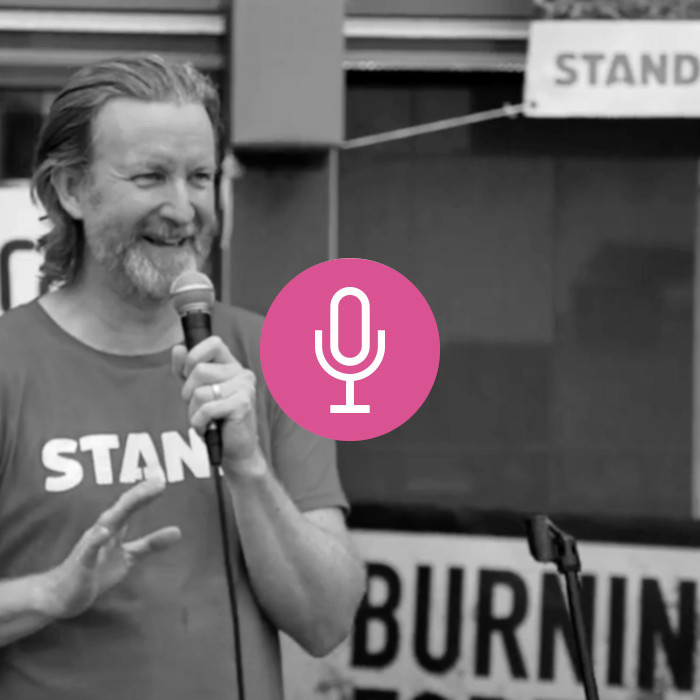Our editors asked Ember analyst and COO Phil MacDonald about their research into the potential costs to the UK of Drax building and running the world’s first BECCS (biomass energy with carbon capture and storage) plant, and whether or not he thought it would actually work.
Can you give us a summary of your report?
Phil MacDonald: Of course. The UK energy company Drax is looking for a new way to keep running now that the government has said subsidy for its biomass power plant will have to end in 2027. The company has proposed a new “negative-emissions” BECCS plant (biomass energy with carbon capture and storage), which would be a world first. It’s well known that to run such a plant will require significant public investment, but until now there’s been no estimate in the public domain on how much it might cost. Our report estimates that a subsidy of more than £30 billion will be necessary to build and run the plant, which is equivalent to adding £16 a year to every household’s energy bill. Our paper also highlights that, due to the risks of high carbon emissions from harvesting and burning wood, Drax’s new power plant may not be able to deliver negative emissions at the scale or in the timeframe it promises.
So you’re questioning its development?
Phil MacDonald: We’re not questioning the need for a lot more government-supported research and pilot projects in negative emissions. Currently, these make up a significant chunk of the government’s plan to reach net zero in 2050. However, there’s been little public discussion around BECCS to date, especially around the idea of building a commercial scale BECCS plant, and our analysis is a first step towards increasing transparency around costs. It’s now essential that Drax releases its own cost and subsidy estimates, so the public can decide if BECCS is a worthwhile investment for the UK.
But our concerns are not just about cost. The best and most recent research challenges the basic assumptions underlying the case for BECCS. Indeed the European Academies Science Advisory Council (EASAC), which brings together national scientific societies including the UK’s Royal Society, now states that using woody biomass for power “is not effective in mitigating climate change and may even increase the risk of dangerous climate change.” We share the concerns of the Climate Change Committee that regulations on what wood can be burnt are not yet robust enough. We need a cast-iron guarantee that any BECCS project does not use wood from primary, high-carbon, highly biodiverse or slow-growing forests, because if that wood is used, a BECCS project could actually be a net-emitter.
Your report gives a conservative estimate for the cost of the proposed power plant as £31.7bn?
Phil MacDonald: Drax has released very little information on what the technology will actually deliver, and they have said nothing on how much it will cost the UK public. That’s why we released what we understand to be the very first public estimate on the cost to the consumer of the proposed Drax BECCS plant.
Can you give us a response to some of Drax’s main claims around the Ember report?
Phil MacDonald: The coverage we received (in the Sun, the Daily Mail and elsewhere) prompted a response from Drax—though unfortunately the response didn’t actually reveal any of Drax’s internal cost estimates.
Drax claim:
“The calculations included in this report [Ember report on BECCS] are based on a series of false assumptions that do not reflect our current proposals to deliver carbon negative power at Drax.
“Firstly, key figures generated by the report relate to the building of a brand new BECCS power station, as opposed to the ‘retrofit’ scheme that is being planned by Drax.”
Phil MacDonald: It probably goes without saying that when we [Ember] undertake this kind of research, we aim to get the most accurate, evidence based analysis of what the costs and effectiveness of such a project might be. The figures we worked with are from the BEIS commissioned report on BECCS costs, published this year. There are no public estimates from BEIS or Drax for the cost savings enabled through a retrofit, and we have two key challenges to the retrofit concept: 1) will a retrofit be efficient enough at burning the limited supply of wood?; 2) given this is a first-of-a-kind plant, will a retrofit really be less expensive than ‘new build’?
If Drax can demonstrate true negative emissions from its BECCS plant, the country will need it to run well past 2050. It’s not at all clear a retrofit will be capable of this.
Drax commissioned the coal units it plans to use for BECCS in the 1970s and 80s. The plant infrastructure could be as much as 60 years old when the BECCS plant begins running. Old equipment can have a real impact on plant efficiency—meaning Drax has to burn more wood for less power. Ember has had conversations with other utilities exploring CCS who are emphatic on the need to demolish and rebuild to make a plant worthwhile from a cost and CO2 capture perspective.
As we state in the report, the figures we have used from BEIS are for a new “nth” of a kind BECCS power plant. This already incorporates cost savings (~15%) compared to a new first of a kind BECCS power plant, which is what Drax’s proposed plant would be. It remains to be seen whether the cost savings that Drax could theoretically achieve through retrofitting their plant will outweigh the increased costs incurred from unforeseen challenges that are an inherent risk as a first-of-a-kind project and from the technical challenges of retrofitting a 40 year old former coal plant that was not built with CCS in mind.
Drax claim:
“In addition, it is claimed that Drax will develop carbon capture and storage (CCS) across all four of its biomass units when in fact its current plans include the conversion of only two units.”
Phil MacDonald: It’s a little strange, because this statement by Drax contradicts the earlier statements they have made. The company has currently submitted two units for planning permission, but has committed to fit all four units with biomass by 2035 (Drax, Nov 2019). Have their plans now changed?
Here’s an infographic (published by Drax at the end of 2019) that Ember refers to, that sets out their full plans.
 Drax claim:
Drax claim:
“Finally, the report assumes any Government support contract, or CfD, would be for a 25 year period, as opposed to the 15 year contract length which is currently being envisaged by Government for CCS projects and would therefore be consistent with its support for other low carbon/renewable technologies such as offshore wind.”
Phil MacDonald: The BEIS commissioned study we use for our analysis is the most recent available estimate for the cost of BECCS. In the study, an assumption is made of a 25 year lifetime for a BECCS plant – to gain an adequate return on investment, a 15 year contract would require an even higher subsidy per unit of power delivered. Furthermore, BECCS is not the same technology as the industrial CCS projects Drax appears to be referring to (it would serve a very different purpose, of generating negative emissions – rather than just abating them), and therefore would not necessarily be procured under the same contract arrangements.
Unlike a wind farm, which can pay for itself by selling power, BECCS will require subsidy across its entire lifetime. Despite aggressive cost-cutting by Drax, biomass feedstock remains a substantial and ongoing cost, as does the cost of CO2 storage. It is inconceivable that a BECCS plant will ever operate without financial support: the economics are clear—if the plant isn’t rewarded for its negative emissions, it will stop operating.
Hinkley Nuclear Power Plant may be a closer parallel for Drax BECCS, given it’s also a first of a kind plant with extremely high capex [NB Capital expenditure] – although the ongoing opex [Operational Expenditure] will be higher at a BECCS plant. Hinkley has won a 35 year CfD contract. If the BECCS plant were to win that contract length, our mid-range estimate is that it could cost £44 billion (range £33 billion – £66 billion).
Drax claim:
“By 2030, the introduction of BECCS on just two of Drax’s biomass units could capture around eight million tonnes of CO2 each year, equivalent to 40% of the Climate Change Committee’s 2050 net zero BECCS power target, and it is widely recognised that in order for the UK to reach its legally binding net zero target, negative emissions technologies like BECCS must be deployed.”
Phil MacDonald: We think it’s very important to underline that capturing eight million tonnes of CO2 every year is not equivalent to 8 million tonnes of negative emissions. Accounting for negative emissions must include the full life cycle carbon emissions of harvesting the wood, turning it into pellets, and transporting it from around the world to Drax. So the negative emissions promised may amount to a carbon accounting sleight of hand, without a full assessment of the biomass sourcing. And one of many scientific warnings on bioenergy use was given in research from Nature Communications (2018) that “expansion of bioenergy in order to meet the 1.5C limit could cause net losses in carbon from the land surface.”
Drax claim:
“BECCS at Drax will save the UK more than £4.5bn over the coming decade, as well as removing millions of tonnes of CO2 from the atmosphere and supporting tens of thousands of jobs.”
Phil MacDonald: The Drax-commissioned study cited [PDF] is an example of the ‘moral hazard’ which the promise of negative emissions can present. The study demonstrates how BECCS allows the UK to avoid reducing emissions from “agriculture, aviation and certain heavy industries”. These emissions reductions are perceived to be costly and difficult to achieve, and so despite its large cost to the energy billpayer, BECCS is assumed to grant an overall saving to the UK economy.
This assessment is potentially misleading, because the Drax-commissioned research rests on a double assumption: that BECCS can truly deliver negative emissions – which has not yet been demonstrated anywhere in the world; and that other emissions reductions will be too expensive to achieve – which we don’t feel has been fully explored.
For a more transparent debate of the costs and benefits of the BECCs plant to the UK’s energy and climate objectives we would invite Drax to provide an estimate of the subsidy they expect from the government and the duration over which they would hope for it to be paid. Doing so would help further robust analysis of the choices that need to be made on reaching net-zero. BECCS may or may not have a place in the transition, but given the high price and high risk, the government needs a much deeper understanding before it presses ahead.




